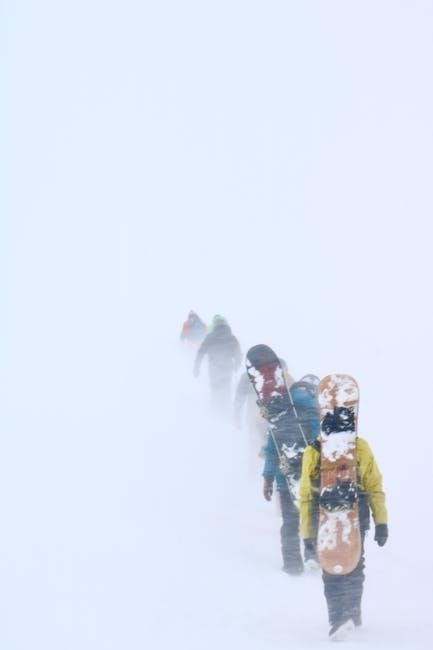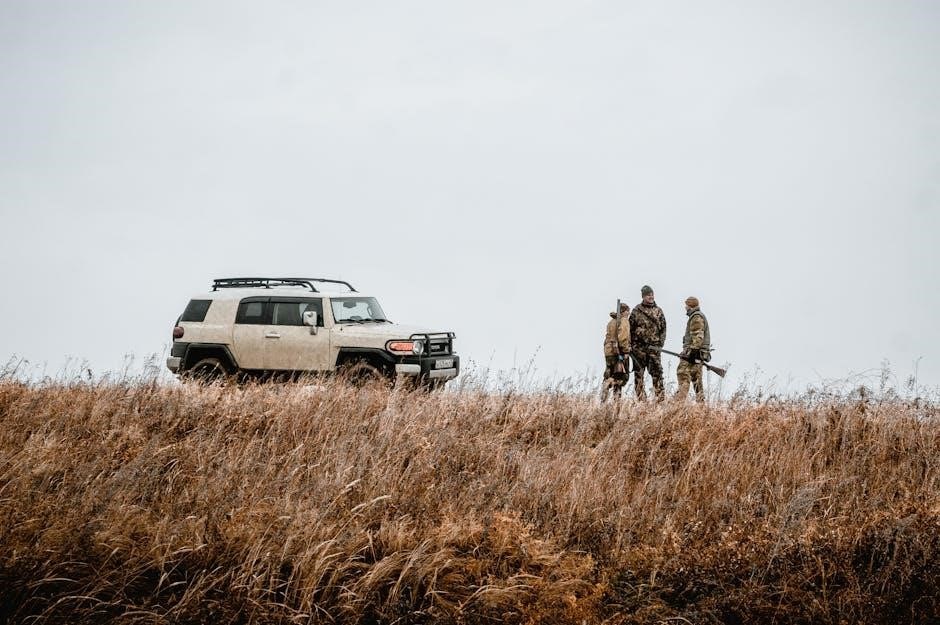Wilderness long-term survival requires preparedness, essential skills, and mental resilience. Understanding how to sustain yourself in nature ensures not just survival, but the ability to thrive in challenging environments effectively.
Understanding the Importance of Wilderness Survival Skills
Wilderness survival skills are crucial for staying safe and self-sufficient in remote environments. They empower individuals to source water, build shelter, and manage resources, ensuring long-term sustainability. These skills foster mental resilience, adaptability, and confidence, enabling one to thrive, not just survive, in nature; Mastery of these techniques is vital for emergencies and extended wilderness adventures, providing a foundation for living independently in the wild.

Mental Preparation and the Survival Mindset
Mental preparation is key to wilderness survival. A positive mindset helps manage fear and anxiety, promoting clear thinking and effective problem-solving. Staying focused and calm enhances decision-making. Building confidence through skills and knowledge strengthens resilience. Maintaining discipline and adaptability ensures resourcefulness. A strong survival mindset transforms challenges into opportunities, fostering growth and self-reliance; It’s about thriving, not just surviving.
Essential Skills for Wilderness Survival
Essential skills include finding and purifying water, building shelters, starting fires, and signaling for help. These skills are crucial for staying safe and alive in the wilderness.
Finding and Purifying Water Sources
Finding and purifying water is critical for survival. Locate sources like streams, ponds, or springs. Use methods such as boiling, sand filtration, or solar disinfection to purify water. Always prioritize water safety to avoid contaminants and ensure hydration. Learning these techniques is essential for long-term wilderness survival and maintaining health in remote environments.
Building Shelter in Different Environments
Building shelter is vital for protection from harsh weather. In forests, construct lean-tos or debris huts using branches and leaves. In snowy areas, create snow trenches or igloos for insulation. In deserts, use sand and rocks to build simple windbreaks. Always ensure proper drainage and ventilation. Adapt your shelter to the environment, using available materials to safeguard against extreme temperatures and weather conditions, ensuring safety and comfort during your wilderness stay.
Starting a Fire Without Modern Tools
Starting a fire without modern tools is a critical survival skill. Use techniques like flint and steel, bow drill, or hand drill to ignite tinder. Prepare dry, fluffy material and arrange kindling in a teepee or log cabin structure. Solar fire starting with a magnifying glass or clear plastic can also work. Maintain patience and persistence, as creating sparks requires effort. Once lit, add larger logs to sustain the fire for warmth, cooking, and signaling purposes effectively.
Signaling for Help and Rescue
Signaling is crucial for rescue in wilderness survival. Use smoke signals during the day, creating three short bursts to indicate distress. At night, build a large fire or use a flashlight to signal rescuers. Create visible markers like “HELP” or “SOS” using rocks or logs. Use a mirror or shiny object to reflect sunlight toward aircraft. Whistle loudly, as the international distress signal is three short blasts. Stay visible and persistent to increase chances of being spotted and rescued effectively.

Food Procurement in the Wild
Food procurement is a critical skill in wilderness survival, involving foraging for edible plants, hunting, trapping, and fishing. It requires knowledge and effective use of tools to sustain life.
Foraging for Edible Plants and Berries
Foraging is a sustainable way to procure food in the wild, requiring knowledge of edible plants and berries. Identify plants using field guides or expert advice to avoid toxic species. Common edibles include dandelion greens, wild garlic, and berries like blueberries or raspberries. Always ensure plants are free from pesticides or pollution. Practice caution and patience while foraging to maintain safety and efficiency in your wilderness survival journey.

Hunting and Trapping Wildlife
Hunting and trapping wildlife are crucial skills for long-term wilderness survival, providing a reliable food source. Use tools like snares, traps, and primitive weapons to catch small or large game. Ethical practices ensure sustainability, focusing on what’s necessary for survival. Processing game safely is essential to avoid waste and maintain nutrition. These methods require patience, knowledge of animal behavior, and adherence to safety protocols to ensure success and minimize risks in the wild.
Fishing Techniques for Survival
Fishing is a sustainable method for obtaining food in the wild. Techniques include knot-tying for durable lines, spearfishing in shallow waters, and using makeshift hooks crafted from bone or metal scraps. Traps can be built using sticks and nets made from clothing. Patience and knowledge of fish behavior are key. These methods provide a reliable food source, essential for long-term survival, and help maintain energy for other critical tasks.

Shelter and Protection
Constructing shelters like lean-tos or debris huts using branches and leaves provides protection from harsh weather. Ensuring proper insulation and protection from wildlife is crucial for long-term survival, conserving energy while maintaining safety in the wild.
Types of Shelters for Various Climates
In wilderness survival, constructing shelters tailored to specific climates is vital. For cold climates, snow shelters like quinzhees or igloos provide insulation. In hot, dry environments, simple lean-tos or tents made from natural materials offer shade. For rainy or forested areas, debris huts with sloped roofs prevent water accumulation. Understanding how to adapt shelter construction to different climates ensures protection from extreme weather, enhancing long-term survival chances in diverse environments effectively.
Protecting Yourself from Extreme Weather

Protecting yourself from extreme weather is crucial for long-term survival. Dress in layers to maintain body heat in cold conditions, and use breathable fabrics in hot climates. Stay dry to avoid hypothermia, and seek shade or create a canopy in intense heat. Build windbreaks or snow walls in cold, windy environments. Always prioritize having a reliable shelter and know how to start a fire to stay warm and dry, regardless of the weather conditions you face.
Defending Against Wildlife Threats
Defending against wildlife threats requires awareness and preparedness. Stay calm and avoid sudden movements to prevent provoking animals. Make noise while hiking to avoid surprising wildlife. Keep food and trash secure to deter attractants. Carry bear spray or other deterrents for emergencies. Know how to identify and respond to specific threats, such as aggressive behavior in bears or snakes. Use sticks, rocks, or other tools as last-resort defenses. Stay in groups when possible, as predators often target lone individuals.

Fire Starting and Management
Fire starting and management are crucial for survival, providing warmth, cooking food, and signaling for help. Mastering these skills boosts confidence and enhances safety in the wild.

Techniques for Starting a Fire
Starting a fire in the wild is essential for survival. Techniques include using flint and steel, ferro rods, or bow drills. Prepare by gathering dry tinder, kindling, and larger logs. Shield the fire from wind and rain to maintain its strength. Practice these methods to build confidence and ensure reliability in emergencies. Fire starting is a fundamental skill for warmth, cooking, and signaling, making it a critical component of long-term wilderness survival.
Uses of Fire in Survival Situations
Fire is a cornerstone of wilderness survival, serving multiple critical purposes. It provides warmth to prevent hypothermia, cooks food to make it safe and nutritious, and purifies water by boiling. Fire also acts as a signal for rescue and can deter wildlife. Additionally, it boosts morale, offering psychological comfort during stressful situations. Mastering fire’s uses enhances overall survival capabilities, making it an indispensable tool in long-term wilderness survival scenarios.
Safety Precautions with Fire
Fire safety is crucial to prevent wildfires and ensure safe survival practices. Keep fires small and controlled, clearing flammable materials from the surrounding area. Use existing fire rings or pits when available to minimize environmental impact. Completely extinguish fires using the “drown, stir, repeat” method, ensuring no embers remain. Always be aware of local fire bans and regulations to avoid legal issues and protect the ecosystem. Proper fire management is essential for both safety and environmental preservation.
Navigation and Orientation
Mastering navigation and orientation is vital for wilderness survival. Use natural signs like the sun’s position, stars, and landmarks to determine direction. Understand maps, compasses, and GPS basics to stay on course and locate essential resources effectively while minimizing the risk of getting lost in remote areas.
Using Natural Signs for Navigation
Navigating in the wilderness often relies on natural signs. The sun rises in the east and sets in the west, while the North Star indicates north. Landmarks like mountains, rivers, and valleys help maintain direction. Moss typically grows thicker on the north side of trees, and animal tracks often lead to water sources. Pay attention to slopes, as they usually descend toward water. Use these natural indicators to stay oriented and avoid disorientation in remote areas effectively.
Understanding Maps and Compasses
Mastering maps and compasses is crucial for wilderness navigation. A map’s scale and legend provide essential details, while contour lines indicate terrain features. The compass’s needle points north, aligning with magnetic fields. By triangulating landmarks and using bearings, you can pinpoint locations. Practice reading topographic maps to identify elevation, water sources, and trails. Combining map-reading skills with compass use ensures accurate navigation, even in remote areas with no GPS access. This skill is vital for long-term survival in the wild.
GPS Navigation Basics
GPS navigation is a valuable tool for wilderness survival, providing precise location data. Understand how to use waypoints, tracks, and routes to mark essential locations like water sources and shelters. Enter coordinates correctly using latitude and longitude. GPS devices require clear satellite signals, so avoid dense forests or deep canyons. Always carry extra batteries and know how to use map and compass as a backup. This ensures reliable navigation in remote areas with limited visibility or connectivity.

Health and Hygiene
Maintaining health in the wild involves preventing illnesses, treating injuries, and keeping hygiene. Clean water, proper wound care, and mental stability are crucial for long-term survival.
Preventing Illnesses in the Wild
Preventing illnesses in the wild is crucial for long-term survival. Prioritize clean water sources, proper handwashing, and safe food handling to avoid waterborne pathogens and infections. Maintain personal hygiene by keeping wounds clean and covered. Avoid consuming contaminated or spoiled food, and stay aware of your surroundings to reduce exposure to harmful bacteria, viruses, and parasites. Regularly sanitizing gear and avoiding close contact with sick individuals further minimizes health risks in remote environments.
Treating Injuries with Limited Resources
Treating injuries in the wild requires immediate action to prevent infection. Stop bleeding with direct pressure and clean wounds with clean water or antiseptic solutions. Immobilize fractures or sprains using splints or makeshift braces. Monitor for signs of infection, such as redness or swelling, and apply herbal remedies if available. Keep wounds covered to protect from dirt and insects, ensuring proper healing and minimizing the risk of complications in remote environments.
Maintaining Mental Health
Maintaining mental health is crucial for long-term wilderness survival. Stay positive by setting achievable goals and focusing on survival tasks. Manage fear and anxiety through mindfulness and deep breathing exercises. Engage in activities like journaling or meditation to maintain emotional balance. Building a routine helps create a sense of normalcy, while staying connected to nature can boost morale. A clear mind enhances decision-making, increasing your chances of survival and eventual rescue.

Wildlife and Insects
Understanding wildlife behavior and insect threats is vital for survival. Avoid habitats of dangerous animals, use repellents, and stay calm during encounters. Protect yourself from insect bites to prevent diseases and discomfort, ensuring safety in the wild.
Handling Encounters with Dangerous Animals
When encountering dangerous animals, remain calm and assess the situation. For bears, avoid direct eye contact and slowly back away; if attacked, use bear spray or fight back as a last resort. Stay on marked trails and make noise to avoid surprising wildlife. If bitten by a snake, stay still, keep the affected limb immobilized, and seek medical help immediately. Carry a first aid kit and know basic wound care. Making noise while hiking and carrying bear spray can help prevent encounters. Recognize signs of aggression in animals like moose or wild boars, and be prepared to react appropriately; Plan ahead, stay informed, and consider taking a survival course to enhance your preparedness and safety in the wilderness.
Managing Insect Bites and Stings
Prevent insect bites by wearing protective clothing, using repellents containing DEET or picaridin, and avoiding sweet-smelling perfumes. If stung, remove the stinger promptly and clean the area with soap and water. Apply a cold compress to reduce swelling. For allergic reactions, administer epinephrine if available and seek immediate medical help. For minor reactions, use antihistamines or topical creams to ease itching. Avoid scratching to prevent infection. Carry a first aid kit equipped for allergic reactions and know basic wound care to manage bites effectively in the wilderness.
Survival Tools and Gear
Essential tools for wilderness survival include a sturdy knife, ferro rod, paracord, water filter, and first aid kit. These items are versatile and crucial for long-term survival.
Essential Items for a Survival Kit
- A sturdy knife for cutting and carving materials.
- A ferro rod for starting fires without matches.
- Paracord for creating shelter and securing gear.
- Water purification tablets or a portable filter.
- A first aid kit with bandages and antiseptics.
- A flashlight or headlamp with extra batteries.
- A multi-tool for various tasks and repairs.
- Signaling devices like a mirror or flares.
- A small repair kit with duct tape and rope.
These items are crucial for long-term wilderness survival, ensuring you can meet basic needs and respond to emergencies effectively.
Using Multi-Purpose Tools Effectively
Multi-purpose tools are indispensable in wilderness survival, offering versatility and efficiency. A good multi-tool can perform tasks like cutting, slicing, and tightening, while a knife serves for carving, self-defense, and preparing food. Fire starters, such as ferro rods, are essential for igniting fires, a crucial element for warmth and cooking. By mastering these tools, you can adapt to various challenges, ensuring resourcefulness and sustainability in long-term survival scenarios.
Mental and Emotional Resilience
Mental and emotional resilience are crucial for long-term wilderness survival. Maintaining a positive mindset, managing fear, and fostering teamwork can enhance decision-making and overall endurance in challenging environments.
Staying Positive in Survival Situations
Maintaining a positive mindset is vital for long-term wilderness survival. Focus on achievable goals, like finding water or shelter, to build confidence. Embrace challenges as opportunities to learn and grow, rather than obstacles. Cultivate gratitude for small victories, such as a warm fire or a safe meal. Positivity fosters resilience, enabling better decision-making and increasing chances of survival. Stay present and avoid overwhelming yourself with worst-case scenarios.
Managing Fear and Anxiety
Recognize and acknowledge fear to maintain control. Practice controlled breathing to calm your mind. Refocus on immediate tasks to avoid overwhelming thoughts. Break challenges into manageable steps to build confidence. Positive self-talk and visualizing success can bolster mental strength. Accepting the situation fosters resilience, while panic clouds judgment. Stay grounded in the present and remind yourself of your ability to adapt and overcome adversity. Managing fear is as crucial as mastering physical survival skills.
Teamwork and Communication
Effective teamwork and communication are vital in wilderness survival. Collaborate to share responsibilities, leveraging individual strengths to enhance group safety. Clear communication ensures everyone understands roles and plans, reducing misunderstandings. Active listening and expressing concerns respectfully foster trust and unity; Encourage open dialogue to address fears and ideas, promoting a cohesive strategy. Strong teamwork and communication build resilience, ensuring collective efforts toward survival and well-being in challenging environments.
Long-Term Survival Strategies
Mastering long-term survival involves rationing supplies, planning for future needs, and adapting to environmental changes. Sustainable practices ensure extended stay in wilderness with minimal ecological impact.
Sustaining Food and Water Supplies
Sustaining food and water is vital for long-term survival. Ration supplies carefully and locate reliable water sources like streams or rain collection systems. Purify water using methods like boiling, filters, or solar disinfection. Forage for edible plants and fish sustainably to maintain food stocks. Use tools like traps or fishing gear to procure protein without depleting resources. Balance calorie intake with energy expenditure to ensure long-term sustainability in the wilderness environment.
Energy Conservation Techniques
Conserving energy is crucial for long-term survival. Minimize physical exertion by planning tasks efficiently and avoiding unnecessary movements. Use tools like spears or traps to hunt, reducing energy spent on manual labor. Rest during extreme heat or cold to preserve stamina. Pace activities according to energy levels and prioritize essential tasks. Maintain a balanced mental state to avoid stress-induced fatigue, ensuring longevity in survival situations. Effective energy management enhances endurance and sustainability in the wilderness.
Planning for Eventual Rescue
Effective planning for rescue involves creating visible signals and maintaining visibility. Use smoke during the day and fires at night to attract attention. Stay in one location to make it easier for rescuers to find you. Utilize tools like mirrors or shiny objects to reflect sunlight toward aircraft. Keep signaling devices accessible and conserve energy for prolonged efforts. Stay proactive and visible to increase chances of being spotted and rescued efficiently in wilderness situations.
Mastering wilderness survival requires resilience, knowledge, and preparedness. By integrating skills, mindset, and resourcefulness, you can navigate challenges and thrive in the wild, ensuring long-term survival and safety.
Wilderness survival hinges on preparedness, mental resilience, and mastering essential skills. Prioritize finding safe water, building shelter, and starting a fire. Signal for help effectively and use tools wisely. Stay positive, conserve energy, and adapt to your environment. Understanding navigation, foraging, and self-defense is crucial. Plan for long-term sustenance and rescue, while maintaining mental health. These principles form the foundation for thriving in the wild and ensuring a safe return.
